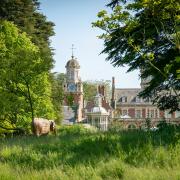Suffolk’s long and fascinating story includes some bloody chapters. Andrew Clarke talks to Robert Leader who brings them to life in his new book
%image(15817069, type="article-full", alt="EADT FEATURE Words Steve Russell Pix Phil Morley 16/11/11 Robert Charles Smith, writing under the pen name of Robert Leader has written a book in the "Bloody British History" series about Bury St Edmunds. Robert is pictured in Bury in the Abbey Ruins in the Abbey Gardens. EADT 19.11.11")
Robert Leader loves a bit of adventure. The Brandon-born author has travelled the world in search of stories to weave into his many thriller and fantasy novels, but now he is seeking inspiration closer to home.
The Suffolk author, who now lives in Bury St Edmunds, has come up with his own literary version of the Horrible Histories TV series and has written Bloody British History: Suffolk, a book bringing together many of the bloodiest, goriest incidents in Suffolk’s past and re-telling them in a page-turning style.
He’s gone for historical bloodshed rather than crime because it reaffirms Suffolk’s role in our country’s changing fortunes.
Robert’s investigations have dug out our gory dealings with the Romans, Vikings, Mary Tudor, Charles I, the Gunpowder Plot, the Spanish Armada, Dutch invaders at Felixstowe and mysterious goings-on at Shingle Street during the Second World War.
%image(15817070, type="article-full", alt="Eastern Angles Boudiccas Babes Marina Morgan as Boudicca Photograph James Fletcher BOADICEA")
For Robert, writing and researching Bloody Suffolk has been a labour of love following on from Bloody Bury St Edmunds, which came out a couple of years ago.
He makes no apologies for not creating a text book that you could use to pass your A-level history exam.
“It’s not a complete history and it’s not intended to be,” he explains. “It’s all about the bloody, gory details with the dreary bits left out.
“It’s not designed for classrooms. It’s not going to teach you all the dry old stuff. Instead it’s an enjoyable romp through all the blood and the battles, revelling in everything that is ghoulish and bizarre.”
For all his disclaimers, there is an awful lot of historical detail buried along with the bodies. The book is laid out in chronological order and Robert sets the scene with plenty of atmosphere, so the events play out in context with their times.
Robert wrote the book as if he were a storyteller, grabbing an audience round a late-night camp fire. The writing style echoes the tradition of oral histories where character and narrative are just as important as dates.
As the author of 40 novels published over the last half century, many of them thrillers, he is well versed in capturing the attention of his readers.
Throughout the 1950s and 1960s, Robert was a prolific writer of thriller, horror and fantasy novels for the publisher Robert Hale, writing under the pen names Robert Leonard and Charles Leader.
His first novel The Faceless Fugitive followed a long series of short stories which he wrote while working on various ships travelling between South America and the Far East via the Mediterranean.
On one trip they found themselves caught up in the Suez Crisis when Egypt’s President Nasser closed the canal and forced them to circumnavigate Africa in order to reach Mombasa.
“We missed the last convoy through the canal by 20 minutes, which was fortunate because the tail end ships in that convoy were sunk by the Egyptians to block the Canal. The bulk of the convoy was trapped there for almost two years.”
It was the opportunity to see other countries and sample other cultures which not only informed his writing but gave him a life-long love of travelling.
“I owned a series of three motor cycles. The first one took me all around the British Isles. The second one took me all around Europe. The third one took me all around Greece. My first car was a little blue Austin A30 which took me down through Spain and all around Morocco. I rode on the Orient Express to Istanbul, flew to Cairo and carried on up the Nile to the Valley of the Kings.
“Out of these trips would come the colour for my next novels. The writing process in those days ideally involved a visit to the planned location, keeping an extensive diary and collecting up all the city maps and tourist literature available. Today of course the internet makes background research so much easier, but the old way was much more exciting and much more fun.
“My second novel was Nothing to Lose, the first in a long series featuring Simon Larren, the killing arm of British Counter Espionage. I had three books written and published before the first James Bond film was made and was poised to catch the rising tide of spy mania. Suddenly every bookshop window in Europe was filled with books with the word Espionage printed large on every cover, and my books were there with the rest.”
This wonderful life continued until the big recession of the early 1980s when the publishing industry shed authors, agents and whole publishing houses as it transformed itself into a global industry dominated by a few multi-national companies.
This left Robert high and dry, so he enrolled as a mature student at the University of East Anglia and studied philosophy, hoping to break into the advertising business before realising, as he put it, “nobody wanted a 48-year-old copywriter”.
Ever adaptable he became a self-employed painter and decorator and, as luck would have it, his writing career suddenly blossomed back into life – writing tourist guides, science fiction and fantasy novels and tales of bloody battles and gory historic murder.
Bloody British History: Suffolk by Robert Leader is published by The History Press.
Robert’s website can be found at www.robertleaderauthor.com/



























